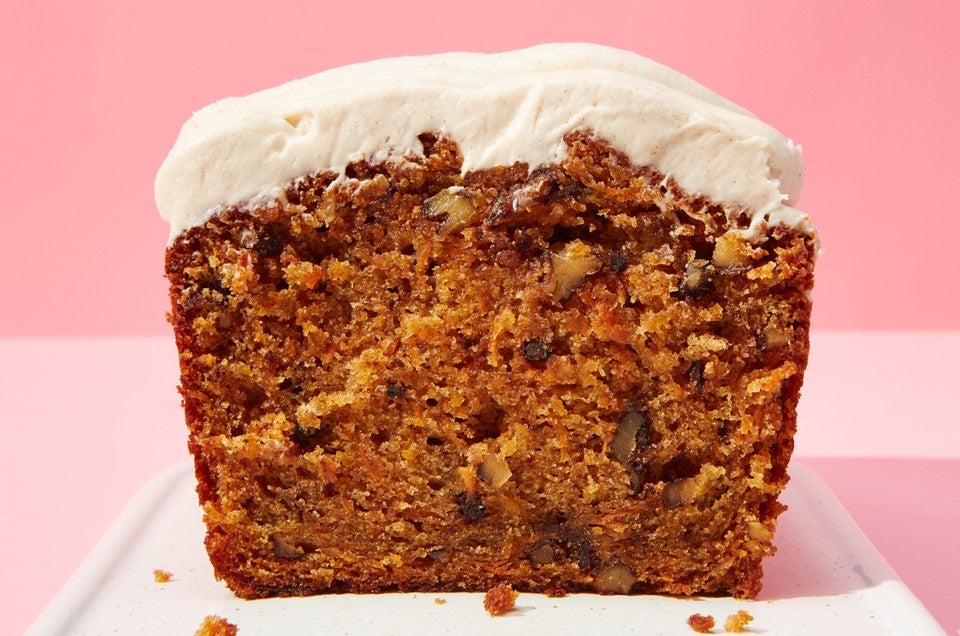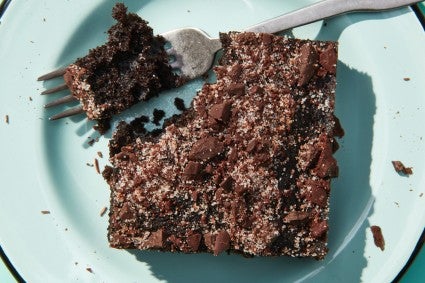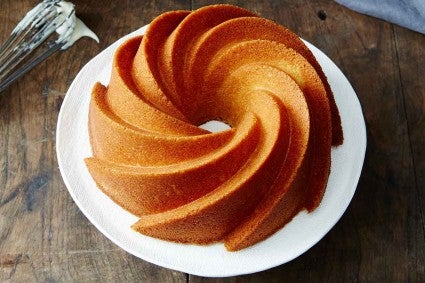


I am not a patient baker. (I’m not a patient anything.) So I’m surprising even myself by telling you that, sometimes, you should wait days (days!) to cut into a cake. I’d heard this argument for abstinence before: headnotes in cookbooks that proclaimed a certain cake tasted even better after a few days, or bakers idly mentioning it about a recipe. A few years back, there was even a whole article published by TASTE that adamantly declared: Age your cake. Still, I was skeptical.
But it turns out that when it comes to aging your cakes, it just might be worth it.
Aging cakes is not a new concept. Think of that old lady in your neighborhood who ages her fruitcakes from Halloween to Christmas. Is this the cake aging we're talking about?
Kind of. But not really.
Fruitcakes are typically aged for weeks, even months, during which they’re regularly bathed with liquor for added moisture and flavor. But for some “regular” cakes, you can wrap them tightly and let them sit for a few days, rather than a few months, before slicing. It may contradict our deeply held notions that fresh-baked is always better, but this rest helps improve both the flavor and texture of certain cakes. The changes are subtle, but noticeable — taste them side-by-side, and you’ll pick up on some deeper flavor notes and added complexity.
That’s the theory, anyway. To test it, I recently baked our Test Kitchen’s new Chocolate Olive Oil Cake, then wrapped it up and left it out for three days on the counter. With each passing day, the chocolate flavor grew a little deeper, and the olive oil notes came through stronger. Was it delicious on day one? Of course. Was the flavor even better by day three? You bet.

So, which cakes are candidates for aging (beyond fruitcake, of course)? Basically, any cake that is dense and moist, with prominent flavors you wouldn’t mind becoming stronger. Carrot cake is a good example: With sharp spice from cinnamon, ginger, and cloves, one of the biggest draws is its combo of complementary flavor notes. If you allow those flavors to deepen and mellow together over the course of a few days, they become even stronger and more enticing.
There are also benefits to texture. Let’s stick with that carrot cake. It’s made with vegetable oil, rather than butter, for extra moisture. According to Claire Saffitz, oil-based cakes are better options for aging, as oil remains in a liquid state at room temperature while butter is solid. As she told Kaitlin Bray for TASTE, “Oil-based cakes that sit on the counter — provided that they’re very well wrapped so there’s no additional moisture loss — stay supple, while the flavor improves.”
King Arthur Recipe Tester Lydia Fournier agrees. “I find that if it's something that has a citrus zest or oil base, it tends to taste stronger on day two or three. That seems to be right in the sweet spot, just before it starts to dry out.”
That carrot cake has one other moisture-boosting ingredient — carrots. As the cake sits, the carrots continue to release moisture, as will any other cake with fruits or vegetables (like zucchini) in it. The same goes for quick breads like banana bread.
Meanwhile, Senior Recipe Developer Susan Reid takes a cue from fruitcake and recommends “anything glazed with booziness,” such as Orange Pound Cake with Bourbon Glaze and Sweet Potato Cake.

Ready to leverage the benefits of a little extra time? Here’s how to do it:
Pick the right recipe: The best cakes for aging are those that are made with oil, have a moist and slightly dense texture, and contain distinct flavors that can bloom and become more pronounced. Light, delicate cakes — particularly those that are egg-based like chiffon or angel food cake, are not good choices.
Hold the frosting: If you’re planning to frost your cake, wait to do so until immediately before serving; leave the cake unfrosted as it ages. Frosting typically has a high ratio of sugar, and sugar is hygroscopic, meaning it literally sucks the moisture out your cake and leaves it dry.
Wrap it up tight: You want to lock in moisture to prevent your cake from drying out during its extended rest. Be sure to completely seal it using an airtight wrap like Bee’s Wrap so that it isn’t exposed to air.
Leave it out at room temperature: No need to chill in the fridge, where the cold air can promote drying. Instead, keep your cakes at room temperature. (Though if you’re stacking layers, chill them briefly before assembling the final cake — it'll make things easier.)
Stay away for one to three days: Flavors will deepen after one day, and only strengthen the longer you wait. That said, you can go too long: age your cakes four days, max (unless it’s a fruitcake or another cake designed to be aged for longer).
Slice and enjoy: Your patience paid off. Time to reap the rewards! In this case, better texture and more nuanced flavor. See? Sometimes it pays to wait.
It’s not just cakes; waiting multiple days to bake bread can be simpler and more flexible. See our previous post for more: Why multiday breads are actually the easiest breads of all.
Cover photo (Spiced Carrot Snacking Cake) by Rick Holbrook; food styling by Kaitlin Wayne.

